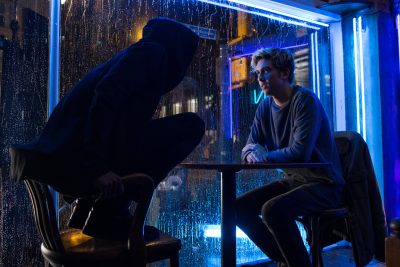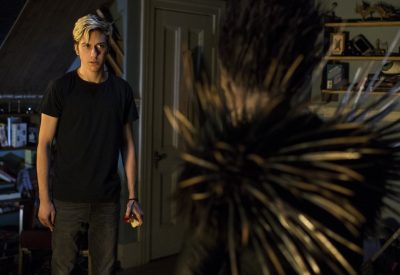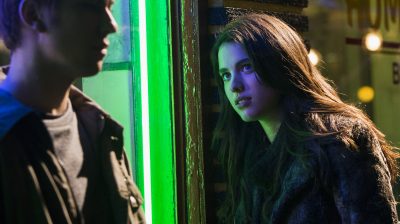
Death Note – L (Lakeith Stanfield) and Light Turner (Nat Wolff) – Photo by James Dittiger/Courtesy of Netflix.
Trying to adapt a 2400-page manga into a 101-minute movie is what used to be called a mug’s game – a task so remarkably daunting/stupid that it wasn’t even worth considering.
Adam Wingard’s Death Note is a bit better than that, but not much.
Death Note opens with Light Turner (Nat Wolff) trying to keep a couple of bullies from picking on a girl. After he wakes up…
No, really, after he wakes up, he’s sitting in the rain and a leather bound notebook falls out of the sky – landing at his feet. He picks it up and sees the words Death Note written on the cover. Curious, he takes it home and cracks it open.
There’s a list of rules (lots of rules), the first of which says that if you write the name of a human being in the journal while picturing his face, that human will die. As he reads, he becomes aware of someone/thing in his room – totally freaking out when Ryuk (voiced by Willem Dafoe), a Shinigami/death god appears.

Death Note – Light Turner (Nat Wolff) and Ryuk (voiced by Willem Dafoe)_ – Photo by James Dittiner/Courtesy of Netflix.
The next day, he witnesses the same bullies picking on someone else and Ryuk goads him into writing one of their names in the book (‘You know you want to…’) and, since there was a note that the writer could pick the manner of death, he writes ‘decapitation.’
Then he watches as events conspire to do exactly that (Shades of Final Destination!). To make sure it wasn’t a coincidence, he sneaks a photo of the man who killed his mother from his father’s safe and does it again. When the man dies, he decides that maybe he could make a difference in the world.
He shares his knowledge with a cheerleader named Mia (Margaret Qualley) and the two set about killing off brutal dictators, mass murders and such. The two decide to let the media know that someone is responsible for these seemingly unrelated deaths – calling him Kira (a Japanese word meaning killer, but also with a significantly different meaning in another couple of languages).
Once ‘Kira’ begins taking credit for the deaths, a mysterious prodigy detective called ‘L’ is brought in by American and international law enforcement agencies. L has deduced that Kira is from Seattle and he and his assistant/guardian Watari (Paul Nakauchi) arrive shortly thereafter – recruiting police Chief James Turner (Shea Whigham) to their team.
Chief Turner is, of course, Light’s dad.

Death Note – Light Turner (Nat Wolff) and Mia Sutton (Margaret Qualley) – Photo by James Dittiger/Courtesy of Netflix.
Learning that L is threatening their anonymity, Light decides to lie low for a while – Ryuk and Mia conspire to counter that and an entire team of FBI agents commit suicide.
In the classic manga, by writer Tsugumi Ohba and illustrator Takeshi Obata, these events take several volumes, but Wingard has scrunched them up into a little over an hour.
And the ensuing chess match between L and Light in the manga feels more like a game of checkers – it’s barely set up, has little to no suspense and results in climax that is forced, abrupt and completely unsatisfying.
Wingard, though, does come up with some marvelous images – L perched on a diner chair across from a slouching Light and Ryuk’s red eyes glowing in the dark are but two of the impressive frames he creates with cinematographer David Tattersall.

Death Note – Ryuk (voiced by Willem Dafoe) – Courtesy of Netflix
Death Note’s biggest problem, though, is one of detail. The original manga is incredibly detailed and precise – and the anime series is as well. Wingard’s film is more mood and tone, with little regard for character or, yes, detail.
If we can sympathize with Light at all, it’s because Wolff provides all the nuance the script does not. His performance – and that of Qualley, who takes a role isn’t particularly well defined (like Wolff’s) and pours a vast enthusiasm into it – keep Death role from being a pretty, pretty disaster.
Dafoe also deserves kudos for giving Ryuk even more menace than his porcupine/pine tree form already has.
That there’s even an overly complex set up for a sequel just adds insult to injury – though it plays into the Final Destination-style of the film’s best onscreen deaths.
Death Note winds up being a great looking misfire.
Final Grade: D+